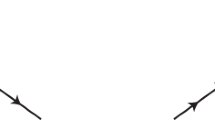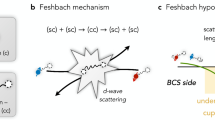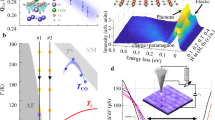Abstract
Superconductivity involves the formation of electron pairs (Cooper pairs) and their condensation into a macroscopic quantum state. In conventional superconductors, such as Nb3Ge and elemental Hg, weakly interacting electrons pair through the electron–phonon interaction. In contrast, unconventional superconductivity occurs in correlated-electron materials in which electronic interactions are significant and the pairing mechanism may not be phononic. In the cuprates, the superconductivity arises on doping charge carriers into the copper–oxygen layers of antiferromagnetic Mott insulators1. Other examples of unconventional superconductors are the heavy-fermion compounds, which are metals with coupled conduction and localized f-shell electrons2, and the recently discovered iron–arsenide superconductors3. These unconventional superconductors show a magnetic resonance, a prominent collective spin-1 excitation mode in the superconducting state4,5,6,7,8. Here we demonstrate the existence of a universal linear relation, Er∝2Δ, between the magnetic resonance energy (Er) and the superconducting pairing gap (Δ), which spans two orders of magnitude in energy. This relationship is valid for the three different classes of unconventional superconductors, which range from being close to the Mott-insulating limit to being on the border of itinerant magnetism. As the common excitonic picture of the resonance has not led to such universality, our observation suggests a much deeper connection between antiferromagnetic fluctuations and unconventional superconductivity.
This is a preview of subscription content, access via your institution
Access options
Subscribe to this journal
Receive 12 print issues and online access
$259.00 per year
only $21.58 per issue
Buy this article
- Purchase on SpringerLink
- Instant access to full article PDF
Prices may be subject to local taxes which are calculated during checkout


Similar content being viewed by others
References
Lee, P. A., Nagaosa, N. & Wen, X. Doping a Mott insulator: Physics of high-temperature superconductivity. Rev. Mod. Phys. 78, 17–85 (2006).
Goll, G. Unconventional Superconductors: Experimental Investigation of the Order-Parameter Symmetry (Springer, 2005).
Kamihara, Y. et al. Iron-based layered superconductor La[O1−xFx]FeAs (x=0.05–0.12) with Tc=26 K. J. Am. Chem. Soc. 130, 3296–3297 (2008).
Rossat-Mignod, J. et al. Neutron scattering study of the YBa2Cu3O6+x system. Physica C 185, 86–92 (1991).
Eschrig, M. The effect of collective spin-1 excitations on electronic spectra in high-Tc superconductors. Adv. Phys. 55, 47–183 (2006).
Sato, N. K. et al. Strong coupling between local moments and superconducting ‘heavy’ electrons in UPd2Al3 . Nature 410, 340–343 (2001).
Stock, C. et al. Spin resonance in the d-wave superconductor CeCoIn5 . Phys. Rev. Lett. 100, 087001 (2008).
Christianson, A. D. et al. Unconventional superconductivity in Ba0.6K0.4Fe2As2 from inelastic neutron scattering. Nature 456, 930–932 (2008).
Pailhès, S. et al. Two resonant magnetic modes in an overdoped high Tc superconductor. Phys. Rev. Lett. 91, 237002 (2003).
Pailhès, S. et al. Resonant magnetic excitations at high energy in superconducting YBa2Cu3O6.85 . Phys. Rev. Lett. 93, 167001 (2004).
Pailhès, S. et al. Doping dependence of bilayer resonant spin excitations in (Y,Ca)Ba2Cu3O6+x . Phys. Rev. Lett. 96, 257001 (2006).
Fong, H. F. et al. Neutron scattering from magnetic excitations in Bi2Sr2CaCu2O8+δ . Nature 398, 588–591 (1999).
Capogna, L. et al. Odd and even magnetic resonant modes in highly overdoped Bi2Sr2CaCu2O8+δ . Phys. Rev. B 75, 060502R (2007).
He, H. et al. Magnetic resonant mode in the single-layer high-temperature superconductor Tl2Ba2CuO6+δ . Science 295, 1045–1047 (2002).
Yu, G. et al. Magnetic resonance in the model high-temperature superconductor HgBa2CuO4+δ. Preprint at <http://arxiv.org/abs/0810.5759> (2008).
Wilson, S. D. et al. Resonance in the electron-doped high-transition-temperature superconductor Pr0.88LaCe0.12CuO4−δ . Nature 442, 59–62 (2006).
Yu, G. et al. Two characteristic energies in the low-energy antiferromagnetic response of the electron-doped high-temperature superconductor Nd2−xCexCuO4+δ. Preprint at <http://arxiv.org/abs/0803.3250> (2008).
Lumsden, M. D. et al. Two-dimensional resonant magnetic excitation in BaFe1.84Co0.16As2 . Phys. Rev. Lett. 102, 107005 (2009).
Christensen, N. B. et al. Dispersive excitations in the high-temperature superconductor La2−xSrxCuO4 . Phys. Rev. Lett. 93, 147002 (2004).
Lipscombe, O. P. et al. Persistence of high-frequency spin fluctuations in overdoped superconducting La2−xSrxCuO4 (x=0.22). Phys. Rev. Lett. 99, 067002 (2007).
Fong, H. F. et al. Spin susceptibility in underdoped YBa2Cu3O6+x . Phys. Rev. B 61, 14773 (2000).
Norman, M. R., Pines, D. & Kallin, C. The pseudogap: Friend or foe of high Tc? Adv. Phys. 54, 715–733 (2005).
Mourachikine, A. The order parameters for pairing and phase coherence in cuprates; the magnetic origin of the coherent gap. The MCS model of high-Tc superconductivity. J. Low Temp. Phys. 117, 401–405 (1999).
Tchernyshyov, O., Norman, M. R. & Chubukov, A. V. Neutron resonance in high-Tc superconductors is not the π particle. Phys. Rev. B 63, 144507 (2001).
Hao, Z. & Chubukov, A. V. Resonance peak in neutron scattering experiments on the cuprates revisited: The case of exciton versus pi-resonance and magnetic plasmon. Phys. Rev. B 79, 224513 (2009).
Brehm, S., Arrigoni, E., Aichhorn, M. & Hanke, W. Theory of two-particle excitations and the magnetic susceptibility in high-Tc cuprate superconductors. Preprint at <http://arxiv.org/abs/0811.0552> (2008).
Yang, J. et al. Exchange boson dynamics in cuprates: Optical conductivity of HgBa2CuO4+δ . Phys. Rev. Lett. 102, 027003 (2009).
van Heumen, E. et al. Optical determination of the relation between the electron–boson coupling function and the critical temperature in high-Tc cuprates. Phys. Rev. B 79, 184512 (2009).
Kee, H.-Y., Kivelson, S. A. & Aeppli, G. Spin-1 neutron resonance peak cannot account for electronic anomalies in the cuprate superconductors. Phys. Rev. Lett. 88, 257002 (2002).
Kyung, B., Sénéchal, D. & Tremblay, A.-M. S. Pairing dynamics in strongly correlated superconductivity. Preprint at <http://arxiv.org/abs/0812.1228> (2008).
Abanov, Ar., Chubukov, A. V., Eschrig, M., Norman, M. R. & Schmalian, J. Neutron resonance in the cuprates and its effect on fermionic excitations. Phys. Rev. Lett. 89, 177002 (2002).
Acknowledgements
We thank A. V. Chubukov, K. K. Gomes, R.-H. He, S. A. Kivelson and A.-M. Tremblay for comments. This work was supported by the US DOE under contract No DE-AC02-76SF00515 and by the NSF under grant No DMR-0705086.
Author information
Authors and Affiliations
Corresponding author
Supplementary information
Supplementary Information
Supplementary Information (PDF 768 kb)
Rights and permissions
About this article
Cite this article
Yu, G., Li, Y., Motoyama, E. et al. A universal relationship between magnetic resonance and superconducting gap in unconventional superconductors. Nature Phys 5, 873–875 (2009). https://doi.org/10.1038/nphys1426
Received:
Accepted:
Published:
Issue date:
DOI: https://doi.org/10.1038/nphys1426
This article is cited by
-
Nodal s± pairing symmetry in an iron-based superconductor with only hole pockets
Nature Physics (2024)
-
Evidence for unconventional superconductivity in twisted trilayer graphene
Nature (2022)
-
Paramagnons and high-temperature superconductivity in a model family of cuprates
Nature Communications (2022)
-
Resonance from antiferromagnetic spin fluctuations for superconductivity in UTe2
Nature (2021)
-
High-energy magnetic excitations from heavy quasiparticles in CeCu2Si2
npj Quantum Materials (2021)



